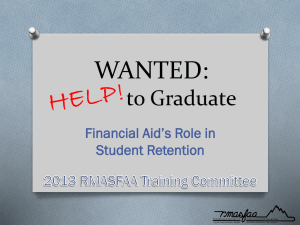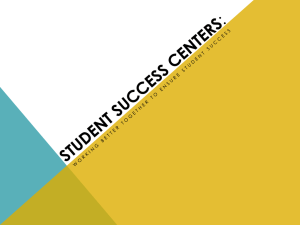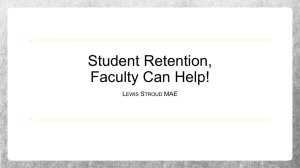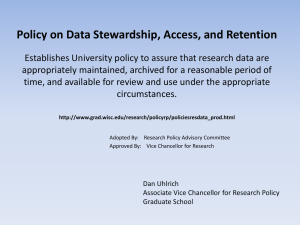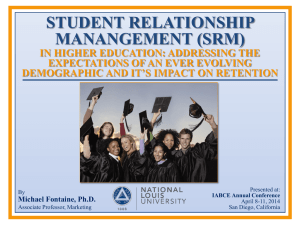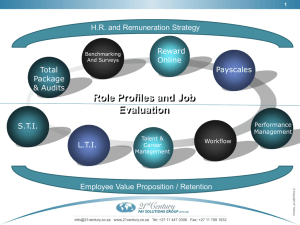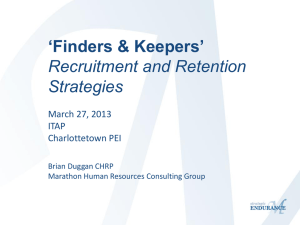RMASFAA States
advertisement
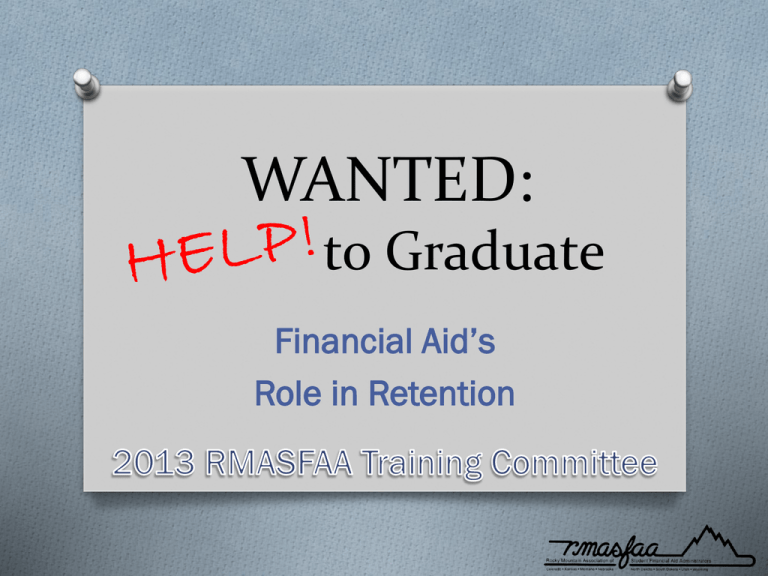
WANTED: to Graduate Financial Aid’s Role in Retention Introduction You (RMASFAA members) voted for it (RMASFAA blog); we (RMASFAA Training Committee) presented on it! THANK YOU for your participation! 2013 Training Committee Why do Students Withdraw? Students who are undecided or who have a less job specific major are more likely to drop out* * Source: Harvard. (2011) Why Should Financial Aid Offices be Concerned? Movement to tie state funds to graduation rates or other performance indicators * Source: NCSL. (2012) FAO Concern: Graduation Rates Total Public and Private (2009) Three-Year Graduation Rates for Associate Students Six-Year Graduation Rates of Bachelor’s Students RMASFAA States RMASFAA States Colorado: 39.3% Kansas: 34.4% Montana: 24.4% Nebraska: 30.3% N. Dakota: 37% S. Dakota: 60.7% Utah: 36.4% Wyoming: 53.9% U.S. Average: 29.2% Colorado: 53.3% Kansas: 53.2% Montana: 45.2% Nebraska: 55.1% N. Dakota: 46.9% S. Dakota: 44.8% Utah: 51.5% Wyoming: 55.4% U.S. Average: 55.5% Source: NCES, IPEDS Graduation Rate Survey FAO Concern: Student Pipeline Rates 9th Grade to College Grad Total Public and Private, Two-Year and Four-Year (2008) RMASFAA States Colorado: 22.2% Kansas: 22.0% Montana: 16.1% Nebraska: 24.9% N. Dakota: 24.6% S. Dakota: 29.5% Utah: 20.8% Wyoming: 25.5% U.S. Average: 20.5% FAO Concern: Default Rate o Borrowers who do not graduate default on their loans at a higher rate than those do. o The average default rate for those borrowers with no degree is more than 4 X the rate for those with a Bachelor’s degree* o Loan default = no Title IV, bad credit reports, collection agency contact, IRS income tax offset, negative impacts on ability to get jobs * Source: Nguyen, M. (2012) Retention Problems vs Financial Aid Solutions The MONEY Issue The MONEY Issue?? Stating “financial reasons” on withdrawal surveys might be easier than listing more personal or difficult reasons. • Financial aid or cost are much more important for “first purchase” than “repurchase” decisions. * • Degrees of dissatisfaction and satisfaction (the latter involving esteem, relationships, etc.) are the real drivers/influencers to re-enrollment behavior. * * Source: Scannell, J. (2011) The MONEY Issue?? Financial issues may be more of a “tipping point” when students are already concerned with: ◦ ◦ ◦ ◦ Academic performance Campus relationships Family issues Work situations Assuming is always the main driver to improved retention rates is not enough * Source: Scannell, J. (2011) The MONEY Issue?? Higher performing students are more likely to transfer out regardless of a financial aid package. * o Thus college cost is not a variable in student selection process for higher performing students.* o VS. * Source: Herzog. (2008) The MONEY Issue Increasing financial aid packages creates only modest improvements in retention ◦ A $1,000 increase in gift aid results in a 2-4% increase in student retention on average.* ◦ Is a marginal benefit worth a large-scale and costly expansion? * Source: Crockett, K, Heffron, M., & Schneider, M. (2011) The MONEY Issue College is expensive Cost of living has continued to go up Families may plan for year one, but not for later years Parent unable/unwilling to help The MONEY Issue Many families experiencing catastrophic financial situations More PLUS loans being denied* ◦ Previously looked at whether applicant had an adverse credit history for an account in the past 90 days ◦ Now looks for delinquent accounts during last 5 years Foreclosures, bankruptcies, wage garnishments, repossessions, tax liens, past due payments. * Source:Vergakis, B. (2013) The MONEY Issue Use endowed funds to respond to increased need among returning students instead of only targeting to academic success o Academically successful students are more likely to be retained anyways* Create grant programs with set criteria so new and continuing students can see stability Have funds that can be used on a case by case basis to holistically assess need and retention * Source: Scannell, J. (2011) The MONEY Issue Do a cost/benefit analysis Identify which populations are most at risk financially. Where do breakpoints occur at various levels of unmet need? * Source: Scannell, J. (2011) Retention Problems vs Financial Aid Solutions The OTHER Issues The REMEDIAL Issue • Students not ready academically for college, put in remedial classes* o >50% of students entering 2 yr colleges and almost 20% of those entering 4 yr colleges are placed in remedial classes.** o Drains money intended to pay for college courses o Students may go into debt over these courses o Reduces student’s chances of success in college * Source: Elliott, S. (2013) ** Source: Complete College America. (2013) The REMEDIAL Issue “The evidence is clear very few students who have this cycle ever graduate from an institution of higher education”* • According to ED, students who are more likely to withdraw are:** o o Students who take any remedial course Students with a GPA below 2.75 * Source: Elliott, S. (2013) ** Source: U.S. Dept. of Education (2002) The ACADEMIC Issue Providing additional in-person counseling Requiring that certain steps in the financial aid process be completed in person. Require loan counseling for any student whose grade point average falls below a certain point. The IDENTITY Issue • Retention requires a degree of connection between student and institution • Withdrawal is failure to make that connection. o Students “… who experienced lower social and academic integration into campus life during their first year of postsecondary education were more likely than others to leave within 3 years”* o Students are at higher risk of withdrawal if they begin attending higher education during any semester other than fall* * Source: U.S. Dept. of Education (2002) The IDENTITY Issue Enhancing connections between financial aid office with academic faculty, advisors, and advocacy offices ◦ Let other offices know that the financial aid office may have solutions Offer presentations to faculty groups and departments ◦ Allow others to report students they are concerned about (financial reasons). Assign a financial aid counselor liaison for each department on campus Communication can be initiated by either office The NEWBIE Issue • Nationally,1st Gen students less likely to attend & persist in college* • Only 26% of 1st Gen students who graduated from high school and enrolled in college, earned a BA within 8 yrs of enrollment (68%)* * Source: Musslewhite & Reeve, (2012) The NEWBIE Issue • Additional diversity amongst these students* o Low income and more likely to be from the lowest income quartile o Age o Level of parent education (none above Associate’s) o Minority; more likely to be Black or Hispanic * Source: Musslewhite & Reeve, (2012) The NEWBIE Issue Participation in Pre-Collegiate & Bridging Programs (TRIO programs) o Upward Bound, Talent Search, Black Issues Forum, Lorenzo de Zavala session, etc… • These types of programs are shown to work for First Generation & minority populations o At CSU a $2,500 annual Partnership Award (renewable) is awarded to incoming freshman who have participated in one of the above mentioned programs The NEWBIE Issue Colorado State University First Generation Award o $4,000 per year, renewable up to 5 years o Student’s parents must NOT have received a bachelor’s degree o Must demonstrate financial need o Must demonstrate potential for academic success o Outreach and Support Programs Department • Provides University connection The NEWBIE Issue Colorado State University (CSU) ◦ Recipient of the Educational Policy Institute’s 2011 Outstanding Student Retention Program award ◦ Commitment to Colorado Promises grant funds at least equal to the amount of annual tuition and fees for Pell grant eligible CO residents Promises grant funds equal to half the amount of annual tuition for CO resident students whose families earn CO’s median household income or less More information: http://www.sfs.colostate.edu/commitment-to-colorado ◦ Student Support Grant Holistic grant that helps students in financial need nearing graduation stay in school. Amount of grant is different for each student and based on multiple factors determined by the financial aid counselor. The COMMUNICATION Issue Social media/networking for financial aid outreach Everybody’s doing it…. Set up a Facebook page or a Twitter account to get the word out to these Millennials and Social Media-friendly parents o o Have school’s main Social Media site (official) send out status reports and tweets of important financial aid events and deadlines • Have the main site “share” your page’s status updates The IGNORANCE Issue • Lack of student and family knowledge of financial aid programs and the financial aid office A 2012 report states that: “College students are generally mentored by their parents and ignore experts (especially online experts).”* * Source: Millennial Branding & StudentAdvisor.com, (2012) The IGNORANCE Issue Start early! Educate! Increasing outreach to middle schools for family financial planning More financially ready students & families The IGNORANCE Issue Financial literacy campaign for new and continuing students o o Classroom workshops o Require completion of an annual program o Peer-to-peer counseling/presenting On-line programs o Publications o Emails OUT REACH Example Cecil Community College (MD) ◦ Campaign to increase financial aid awareness Informational workshops Targeted mailings Phone calls to students eligible for financial aid but had not enrolled ◦ Campaign resulted in financial aid participation rate increase of 33 - 39% in two years Retention rates of financial aid recipients increased slightly at 1% ◦ College expansions Increase staff & computer support in learning centers Retooled career & job placement services * Source: Center for Community College Student Engagement.(2006) OUT REACH Example “Life Coaching” o Programs available for a price available online (ex: universitylifecoach.com) • Stresses goal setting, action planning, resourcing & accountability • Price can be hundreds of dollars, not reasonable for a cash-strapped college student o Offer programs on campus available to students OUT REACH Example Salish Kootenai College o Takes students on financial aid probation due to academic probation, and provides one academic quarter of intensive intrusive advising & skill building • Provides academic help when students may not know how (or be willing) to ask for it • Provides connection with faculty in academic major • Improved persistence rates were shown for these students OUT REACH Example Kansas State University o Offers free financial counseling to students to help with budgeting and managing debt • Met with 220 “clients” on campus Fall 2012 semester, and hope to reach 400 for 2012-2013 year o Offers group financial presentations covering budgeting, credit, student loan repayment and financial planning • For 2011-2012, 94 presentations were given that reached 3,800 individuals • For 2012-2013, 73 presentations have been given thus far OUT REACH Example Sitting Bull College (ND) o Holds Health & Financial Fairs each semester, bringing in local area services to educate student o Holds Student Summit each semester to allow students to ask question and visit with representatives from various departments on campus The BOTTOM LINE • Students who are the most high risk may also be the least responsive to retention efforts* o May not be cost (or time) effective to target this group • Students who are high risk for withdrawal remain high risk throughout their college enrollment* * Source: Singell, L.D. & Waddell, G.R. (2010) Group Discussion What is your office doing to aid in retention? What works and what doesn’t? • • • • Specific aid? Targeting specific groups or case-by-case? Campus Connections? Outreach? References Ackerman, R., & Schibrowsky, J. (2007-2008). A business marketing strategy applied to student retention: A higher education initiative. Journal of College Student Retention: Research, Theory & Practice, 9(3), 307-336. Allen, J., Robbins, S. B., Casillas, A., & Oh, I.-S. (2008, November). Third-year college retention and transfer: Effects of academic performance, motivation, and social connectedness. Research in Higher Education, 49(7), 647-664. doi: 10.1007/s11162-008-9098-3 Bowen, W. G., Chingos, M. M., & McPherson, M. S. (2009). Crossing the finish line. Princeton, NJ: Princeton University Press. Carnevale, A.P.; Jayasundera, T.; and Cheah, B. August 2012. Executive Summary: The College Advantage: Weathering the Economic Storm. Georgetown University Center on Education and the Workforce. Carnevale, A.P.; Rose, S.J.; and Cheah, B. August 2011. The College Payoff: Education, Occupations, Lifetime Earnings. Georgetown University Center on Education and the Workforce. Retrieved from: http://www9.georgetown.edu/grad/gppi/hpi/cew/pdfs/collegepayoff-complete.pdf. Carnevale, A.P.; Smith, N.; and Strohl, J. June 2010. Executive Summary: Help Wanted: Projections of Jobs and Education Requirements Through 2018. Georgetown University Center on Education and the Workforce. Center for Community College Student Engagement. (2006). Act on Fact: Using Data to Improve Student Success. Austin, TX: The University of Texas at Austin, Community College Leadership Program. Complete College America. Spring 2012. Remediation: Higher Education’s Bridge to Nowhere.. Retrieved from: http://www.completecollege.org/docs/CCA-Remediation-final.pdf. pp. 2-3. Crockett, K., Heffron, M., Schneider, M. (2011). Targeting Financial Aid for Improved Retention Outcomes. Noel-Levitz and American Institutes for Research. Retrieved from: http://www.air.org/files/LA_PELL_STUDY_report_1011.pdf Dalton, D., Moore, C. A., & Whittaker, R. (2009, Spring). First-generation, low-income students: Strategies for success at Lyndon State College. The New England Journal of Higher Education, 23(5), 26-27. References cont. Dillon, E., & Smiles, R. V. (2010, February). Lowering student loan default rates: What one consortium of historically black institutions did to succeed. Washington, DC: Education Sector. Domonell, K. (2013). Sequestering Minority Education. University Business 3/26/2013. Ellitot, S. (2013). Indiana legislature bill aims to boost college readiness by typing financial aid to state exams. Retrieved from: http://www.indystar.com/article/20130124/NEWS05/130124042/Bill-aims-boost-college-readiness-by-tying-financialaid-state-exams?gcheck=1&nclick_check=1 Gross, J. P. K., Cekic, O., Hossler, D., & Hillman, N. (2009). What matters in student loan default: A review of the research literature. Journal of Student Financial Aid, 39(1), 19-29. Harvard Graduate School of Education. (2011). Pathways to Prosperity Study. Henderson, S., Tatum, J. (2009). Beyond Leveraging: Financial Aid’s Role in Executing SEM Recruitment and Retention. 19th AACRAO Enrollment Management Conference. Univeristy of Michigan-Dearborn. Retrieved from: http://handouts.aacrao.org/sem19/finished/T0215p_J_Benfield%20Tatum.pdf Herr, E., & Burt, L. (2005). Predicting student loan default for the University of Texas at Austin. Journal of Student Financial Aid, 35(2), 27-49. Herzog. (2008) Journal of Student Financial Aid. 37(3) Millennial Branding and StudentAdvisor.com. (2012). Millennial Branding and StudentAdvisor.com Release New Study on Student Career Development. Retrieved from: http://millennialbranding.com/2012/11/student-career-development-study/ NCHEMS Information Center for Higher Education Policymaking and Analysis, http://www.higheredinfo.org/ National Association of Student Financial Aid Administrators Graduate/Professional Issues Committee. (2005). Debt management strategies: For graduate and professional students. Student Aid Transcript, 16(1), 20-23. National Conference of State Legislatures (NCSL). (2012). Performance Funding for Higher Education. Retrieved from: http://www.ncsl.org/issues-research/educ/performance-funding.aspx References cont. Nguyen, M. February 2012. Degreeless in Debt:What Happens to Borrowers Who Drop Out. Retrieved from: http://www.educationsector.org/publications/degreeless-debt-what-happens-borrowers-who-drop-out O'Neal, S., & Kent, C. (2002). Take one small step: Traveling the path to default reduction. Student Aid Transcript, 13(4), 815. Pinto, M. B., & Mansfield, P. M. (2006). Financially at-risk college students: An exploratory investigation of student loan debt and prioritization of debt repayment. Journal of Student Financial Aid, 35(2), 22-32. Sallie Mae. (2008). 2007 Survey of Parents of College-Bound Freshmen. Retrieved from: http://www.rmasfaa.org/docs/exchange/200803/rme6.html Scannell, J. (2011). The Role of Financial Aid and Retention. Retrieved from: http://www.universitybusiness.com/article/role-financial-aid-and-retention Singell, L. D., & Waddell, G. R. (2010, September). Modeling retention at a large public university: Can at-risk students be identified early enough to treat? Research in Higher Education, 51(6), 546-572. doi: 10.1007/s11162-010-9170-7 Smith, M. (2008). Right on the money: Training students in financial literacy. Student Aid Transcript, 19(3), 6-10. Steiner, M., & Teszler, N. (2005, January). Multivariate analysis of student loan defaulters at Texas A&M University. Round Rock, TX: Texas Guaranteed Student Loan Corporation. Time Ideas. (2012). 8 Ideas to Improve Higher Education. Retrieved from: http://ideas.time.com/2012/10/18/8-ideas-toimprove-higher-education/#slide/tie-funding-to-graduation-rates/?&_suid=13594909150780032817017170189644 USA Today. (2013). Which colleges offer the best value? Retrieved from: http://www.9news.com/news/article/314987/339/Which-colleges-offer-the-best-valueU.S. Department of Education. (2000, October). Ensuring student loan repayment: A national handbook of best practices. Washington, DC: Office of Student Financial Assistance. References cont. U.S. Department of Education. (2002, November). Short-term enrollment in postsecondary education: Student background and institutional differences in reasons for early departure, 1996-98. Washington, DC: National Center for Education Statistics. U.S. Department of Education. (2010). Default prevention and management. Washington, DC: Federal Student Aid. Vergakis, B. (2013). Feds’ loan changes hamper black college enrollment. Associated Press. Retrieved from: http://news.yahoo.com/feds-loan-changes-hamper-black-162929184.html Wilmsen, E. (2011). Educational Policy Institute honors CSU with 2011 Outstanding Student Retention Program award. Today @ Colorado State. Retrieved from: http://www.today.colostate.edu/story.aspx?id=5727
